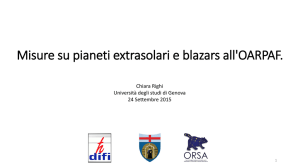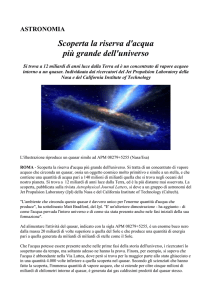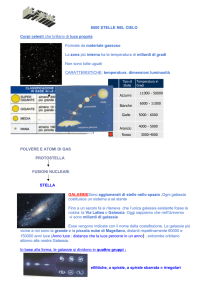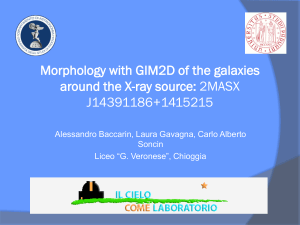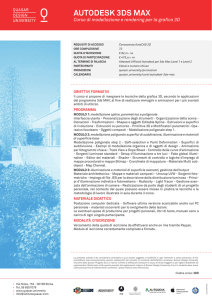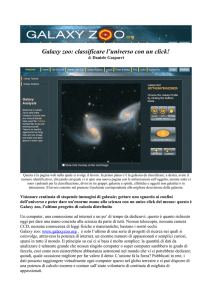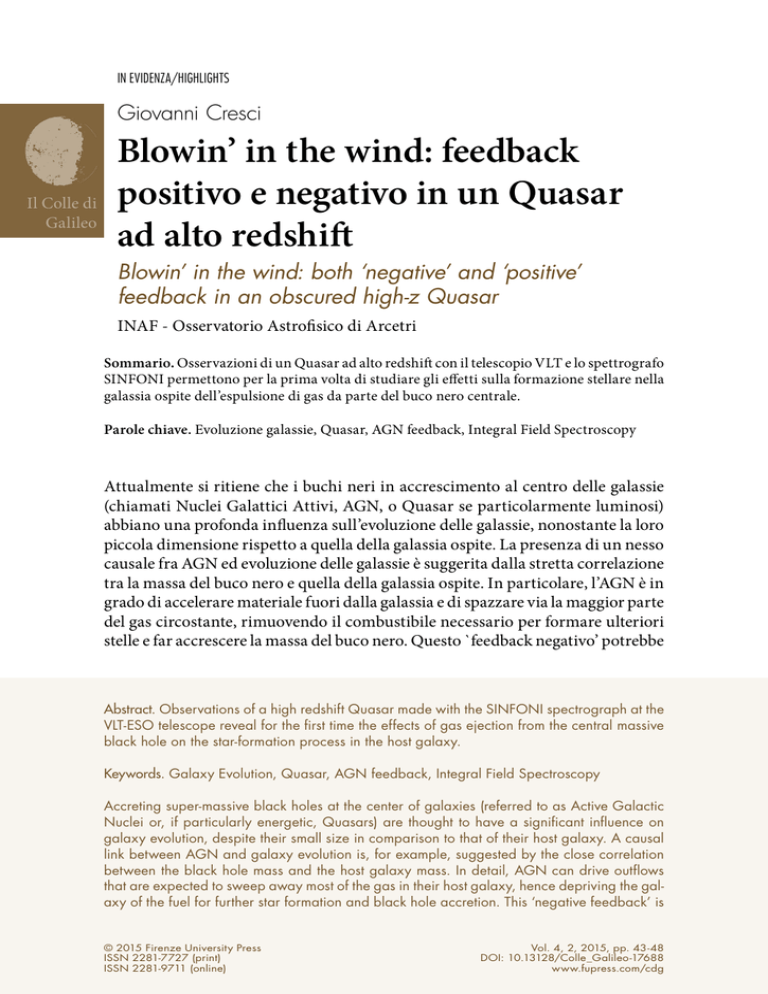
IN EVIDENZA/HIGHLIGHTS
Giovanni Cresci
Il Colle di
Galileo
Blowin’ in the wind: feedback
positivo e negativo in un Quasar
ad alto redshift
Blowin’ in the wind: both ‘negative’ and ‘positive’
feedback in an obscured high-z Quasar
INAF - Osservatorio Astrofisico di Arcetri
Sommario. Osservazioni di un Quasar ad alto redshift con il telescopio VLT e lo spettrografo
SINFONI permettono per la prima volta di studiare gli effetti sulla formazione stellare nella
galassia ospite dell’espulsione di gas da parte del buco nero centrale.
Parole chiave. Evoluzione galassie, Quasar, AGN feedback, Integral Field Spectroscopy
Attualmente si ritiene che i buchi neri in accrescimento al centro delle galassie
(chiamati Nuclei Galattici Attivi, AGN, o Quasar se particolarmente luminosi)
abbiano una profonda influenza sull’evoluzione delle galassie, nonostante la loro
piccola dimensione rispetto a quella della galassia ospite. La presenza di un nesso
causale fra AGN ed evoluzione delle galassie è suggerita dalla stretta correlazione
tra la massa del buco nero e quella della galassia ospite. In particolare, l’AGN è in
grado di accelerare materiale fuori dalla galassia e di spazzare via la maggior parte
del gas circostante, rimuovendo il combustibile necessario per formare ulteriori
stelle e far accrescere la massa del buco nero. Questo `feedback negativo’ potrebbe
Abstract. Observations of a high redshift Quasar made with the SINFONI spectrograph at the
VLT-ESO telescope reveal for the first time the effects of gas ejection from the central massive
black hole on the star-formation process in the host galaxy.
Keywords. Galaxy Evolution, Quasar, AGN feedback, Integral Field Spectroscopy
Accreting super-massive black holes at the center of galaxies (referred to as Active Galactic
Nuclei or, if particularly energetic, Quasars) are thought to have a significant influence on
galaxy evolution, despite their small size in comparison to that of their host galaxy. A causal
link between AGN and galaxy evolution is, for example, suggested by the close correlation
between the black hole mass and the host galaxy mass. In detail, AGN can drive outflows
that are expected to sweep away most of the gas in their host galaxy, hence depriving the galaxy of the fuel for further star formation and black hole accretion. This ‘negative feedback’ is
© 2015 Firenze University Press
ISSN 2281-7727 (print)
ISSN 2281-9711 (online)
Vol. 4, 2, 2015, pp. 43-48
DOI: 10.13128/Colle_Galileo-17688
www.fupress.com/cdg
44
Giovanni Cresci
essere il meccanismo responsabile della mancanza di formazione stellare recente nelle galassie ellittiche, nonché l’agente che impedisce alle galassie di crescere
eccessivamente, spiegando così l’assenza di galassie molto massicce in confronto
alle predizioni dei modelli teorici di formazione delle galassie.
Oltre a questo ‘feedback negativo’ alcuni modelli prevedono che l’AGN fornisca
un ‘feedback positivo’, inducendo piuttosto che sopprimendo la formazione stellare grazie all’aumento della pressione nel mezzo interstellare. Questo ‘feedback
positivo’ potrebbe spiegare la correlazione osservata tra la formazione di stelle
nelle zone nucleari e la luminosità dell’AGN, la relazione fra la massa del buco
nero e quella della galassia e infine l’aumento della formazione di nuove stelle ad
alto redshift quando anche l’accrescimento sul buco nero era maggiore. Trovare però evidenze osservative di questo ‘feedback positivo’ in azione è ancora una
delle maggiori sfide dell’astronomia osservativa extragalattica.
Un team di astronomi guidato dall’autore e che include Alessandro Marconi
(Università di Firenze) e Filippo Mannucci (Osservatorio di Arcetri) ha recentemente presentato uno studio dettagliato di un Quasar a redshift z~1.6 (quando
l’età dell’universo era di 4 miliardi di anni, il 30% di quella attuale) brillante nei
raggi X, ma oscurato dalla polvere nell’ottico. Date le sue proprietà ci si aspettava che il Quasar fosse nella fase iniziale di attività di AGN, ancora circondato da
polvere e che di conseguenza rappresentasse un caso ideale per studiare gli effetti
del ‘feedback’ nel suo periodo di massimo impatto sulla galassia ospite.
Il Quasar (XID2028) è stato osservato con lo spettrografo infrarosso ‘integral
field’ SINFONI al telescopio VLT/ESO. Lo strumento è capace di ottenere simul-
often invoked as the main mechanism responsible for the red colors of elliptical galaxies and
in preventing galaxies from overgrowing, thus explaining the dearth of very massive galaxies
compared to what would be expected from hierarchical galaxy formation models.
In addition to this negative feedback, some models also require AGN to provide a ‘positive’ feedback, inducing star formation rather than suppressing it by increasing the gas pressure in the interstellar medium. Such positive feedback could explain the observed correlation
between nuclear star-formation activity and AGN luminosity, the black-hole mass - galaxy mass
scaling relation and the enhanced star-formation rate at high redshift concurrent with a higher black hole accretion. However, finding observational evidence of the effect of such AGN
negative and positive feedback is still one of the main challenges in extragalactic astronomy.
A team of astronomers led by Giovanni Cresci (INAF-Arcetri Observatory) and including
Alessandro Marconi (University of Florence) and Filippo Mannucci (INAF-Arcetri Observatory) has recently published a detailed study of an X-ray bright but optically-obscured QSO at
redshift z~1.6, the epoch in which the effects of AGN feedback are expected to be more significant for galaxy evolution. Given its properties, the Quasar was expected to be still in the
dust-enshrouded phase typical of the first phases of AGN activity, and therefore to represent
an ideal case for studying feedback at its maximum.
The Quasar (XID2028) was observed with the near-infrared integral field spectrograph
SINFONI at the VLT, which is capable of obtaining simultaneously the spectra of small regions
of sky of 0.125”x0.125”, making it possible to study the physical properties of the different
Giovanni Cresci
Blowin’ in the wind: feedback positivo e negativo in un Quasar ad alto redshift
Figura 1. In alto: Spettro SINFONI in banda J della sorgente XID2028, integrato in una regione di 1”x1” intorno al QSO. Lo spettro osservato è mostrato in nero, mentre il fit delle righe di emissione principali (Hβ
larga per la presenza della Broad Line Region del Quasar, Hβ, [OIII]5007,4959Å) sono mostrati in blu e la
loro somma in rosso. I residui del fit, ovvero la differenza fra lo spettro osservato e il fit, sono mostrati nel
pannello inferiore. Le regioni marcate sono state escluse dal fit a causa della presenza di righe di cielo. In basso: Mappe in [OIII]5007Å ottenute integrando i canali corrispondenti al centro della riga (marcato in rosso
nel pannello superiore) e all’ala blu (in blu). I contorni del centro della riga, che identificano la posizione del
Quasar, sono mostrati in nero in entrambi i pannelli. Nel pannello di sinistra è evidente l’ala ad alta velocità
dovuta alla presenza di un getto di materia che si estende per 1.5” dal Quasar.
Figure 1. Upper panels: J-band SINFONI spectrum of the source XID2028, integrated in a region of 1”x1” aroud the
QSO. The observed spectrum is shown in black, the different broken power-law components in the fit for each line (Hα
large due to the Broad Line Region, Hα, [OIII]4959,5007Å) are shown in blue, while their sum is shown in red. The residuals of the fit, i.e. the difference between the observed and the model spectrum, are shown below. The shaded regions
show the location of sky lines, which were excluded from the fit.
Lower panels: [OIII]5007Å channel maps obtained by integrating the continuum-subtracted SINFONI datacube on the
line core (1.296<λ<1.300 μm, left, see red box in the upper panel) and on the blue wing (1.294<λ<1.296 μm, right, see
blue box in the upper panel). The contours on the line core, marking the position of the central QSO, are shown in black
in both panels. Clearly shown in the left panel is the blue high-velocity wing due to the outflow, extending up to 1.5”
from the QSO position.
Blowin’ in the wind: both ‘negative’ and ‘positive’ feedback in an obscured high-z Quasar
45
46
Giovanni Cresci
taneamente lo spettro di piccole regioni di cielo (0.125”x0.125”), permettendo di
studiare le proprietà fisiche delle differenti regioni della galassia ospite. Lo spettro del Quasar in Fig. 1 mostra la riga di emissione dell’[OIII]5007Å con un’ala
blu molto asimmetrica, segno della presenza di gas ad alta velocità in allontanamento dal Quasar. L’immagine ottenuta integrando lo spettro sull’ala blu della
riga (visibile nel pannello in basso a destra) mostra che la coda blu si estende per
1.5”, corrispondenti a 13 kpc proiettati, dalla posizione del Quasar (cfr. pannello
in basso a sinistra), e raggiunge velocità fino a 1500 km/s lungo la linea di vista.
Si calcola che la quantità di massa espulsa è di circa 1000 Msole/anno più di tre
volte il tasso di formazione stellare nella galassia, confermando così che l’outflow
osservato non può essere alimentato da stelle giovani distribuite in tutta la galassia, ma dalla presenza del Quasar.
Inoltre si sono potuti studiare gli effetti di un outflow di materia così energetico sulla galassia ospite, usando sia dati SINFONI in banda H+K che include la
riga di emissione Hα che immagini ACS/HST nella banda U rest-frame. Entrambi questi traccianti campionano la distribuzione della formazione stellare nella
galassia e dimostrano che l’outflow si trova al centro di una grande cavità (vedi
Fig. 2). Ciò suggerisce uno scenario in cui il potente outflow rimuove il gas dalla galassia ospite lungo il suo percorso, impedisce la formazione di nuove stelle
(‘feedback negativo’), ma allo stesso tempo induce la formazione di stelle comprimendo le nubi di gas ai suoi bordi (‘feedback positivo’).
XID2028 è la prima osservazione diretta di formazione stellare indotta in
un AGN non dominato da potenti getti radio e il primo esempio dei due tipi
regions of the Quasar host galaxy. The spectrum of the Quasar (Fig. 1) reveals a very asymmetric and blue-shifted shape of the [OIII] emission lines: this is evidence of the presence of
a high-velocity gas outflowing from the QSO. The image obtained integrating the spectra
over the blue wing of the [OIII]5007Å line (lower right panel) shows that the blue high velocity wing extends up to 1.5”, i.e. 13 projected kpc from the QSO position (lower left panel),
and reaches velocities up to 1500 km/s towards the line of sight. The estimated mass outflow
rate is ~1000 M(sun)/yr, more than three times the star formation rate in the galaxy, confirming that the outflow observed cannot be sustained by the young stars in the galaxy, but by the
presence of the Quasar.
Moreover, it was possible to study the effects of such energetic outflow on the host galaxy,
using both H+K band SINFONI observations sampling the Hα line and HST-ACS imaging in the
rest frame U band. Tracing the star formation in the host galaxy, both the narrow component of
Hα emission line map and the rest-frame U-band ACS imaging show that the outflow position
lies in the center of a cavity in the star-forming regions of the host galaxy (Fig. 2). This suggests
a scenario in which the powerful outflow is removing the gas from the host galaxy (‘negative
feedback’), but is also triggering star formation through an outflow-driven shock which drives
turbulent compression of the gas clouds especially at the outflow edges (‘positive feedback’).
XID2028 represents the first direct detection of outflow-induced star formation in a radioquiet AGN, as well as the first example of both types of feedback simultaneously at work in
the same galaxy. The data presented demonstrate that both ‘positive’ and ‘negative’ AGN
Giovanni Cresci
Blowin’ in the wind: feedback positivo e negativo in un Quasar ad alto redshift
Figura 2. Mappe nella componente stretta dell’Hα con sovrapposti i contorni dell’emissione rest-frame U-band
osservata da HST (a sinistra) e i contorni dell’outflow in Figura 1 (nel centro). L’outflow si trova esattamente
nella cavità tra il nucleo (marcato da una stella) e le due regioni di formazione stellare A e B. Il pannello di
destra mostra uno schema dello scenario proposto nel quale il potente getto che si origina dall’AGN rimuove
il gas lungo il suo cammino producendo una cavità nella formazione stellare, ma allo stesso tempo innesca
la formazione di nuove stelle ai suoi bordi grazie alla compressione del gas.
Figure 2. Narrow Hα emission map with superposed ACS U-band contours (left) and the contours of the outflow from
Figure 1 (middle). The outflow lies in the cavity between the nucleus (marked with a diamond) and the two star-forming
regions (A and B). The right panel shows a schematic view of the proposed scenario in which the powerful outflow originating from the AGN removes the gas from the host galaxy producing a cavity without star formation, while at the same
time triggering star formation at the edges via turbulent compression of the gas.
feedback are crucial ingredients to shape the evolution of galaxies, by regulating the star formation in the host and driving the black hole-galaxy coevolution. The results show that these
mechanisms are in operation, not only in powerful radio galaxies with relativistic jets, but also
in less extreme objects during an obscured QSO phase that is thought to be a common step
in the evolutionary sequence of star-forming galaxies.
Bibliography
G. Cresci et al. (2015), Astrophysical Journal, 779, 82.
Currently Giovanni Cresci is Research Scientist at the INAF-Arcetri Astrophysical Observatory.
He has worked at the Max Plank Institut fuer Extraterrestrische Physik in Munich-Germany and
at the INAF-Astronomical Observatory of Bologna. He has published over 60 research articles in leading refereed journals, mainly on the chemical and dynamical evolution of galaxies
and on the effects of the AGNs on the host galaxies.
Blowin’ in the wind: both ‘negative’ and ‘positive’ feedback in an obscured high-z Quasar
47
48
Giovanni Cresci
di feedback in azione nello stesso oggetto. I dati presentati dimostrano che sia
il feedback positivo che quello negativo sono ingredienti cruciali nell’evoluzione delle galassie che regolano la formazione stellare e guidano la co-evoluzione
fra galassia e buco nero. I risultati mostrano anche che questi meccanismi sono
in azione non solo in potenti galassie con getti radio, ma anche in oggetti meno
estremi durante la fase oscurata di un Quasar, che si pensa sia una fase comune
nell’evoluzione di una galassia.
Bibliografia
G. Cresci et al. (2015) “Blowin’ in the wind: both ‘negative’ and ‘positive’ feedback
in an obscured high-z Quasar”, Astrophysical Journal, 799, 82.
Giovanni Cresci. Assegnista di Ricerca presso l’INAF – Osservatorio Astrofisico di Arcetri, dopo aver lavorato al Max Planck Institut fuer Extraterrestrische
Physik in Germania e all’Osservatorio di Bologna. Ha pubblicato più di 60 lavori
sulle maggiori riviste con referee, principalmente sull’evoluzione chimica e dinamica delle galassie e sugli effetti degli AGN sulle galassie ospiti.
Giovanni Cresci


